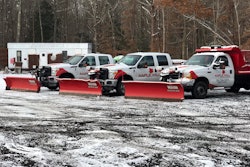

The origins of this tradition of topping this particular species under the conviction that it is a correct form of pruning is a mystery.
Manny Nassar, an ISA certified arborist and a technical advisor with The Davey Tree Expert Company in Florida, says it has been around for at least 20 years and is a practice committed not only by homeowners but landscapers as well.
Here are some of the commonly cited claims that landscapers use to justify their actions and why their rationale doesn’t make crape murder right.
The customer is not always right
Some customers may request their crape myrtle be topped in order to help the plant grow more blooms. While the blooms will be bigger, there will be fewer and they will grow on weak new shoots that tend to flop over and droop after summer rains.
“Most landscapers that carry out this practice usually don’t know any better or the client has asked to have this done,” Nassar says. “This is when educating the client is paramount.”
While the business adage claims that the customer is always right, your company was hired as the professional in this case and it is not your job to bow to a client’s whims. If you were an electrician or plumber, you wouldn’t install something incorrectly just because a homeowner asked you to, so why would you perpetuate an incorrect pruning practice?
 Topping crape myrtles is an often seen practice, but this does not make it right.Photo: Jill Odom/Total Landscape Care
Topping crape myrtles is an often seen practice, but this does not make it right.Photo: Jill Odom/Total Landscape Care
“The landscaper should recommend ‘pencil pruning’ a method used to prune crossing, damaged or diseased smaller limbs within the canopy,” Nassar says. “It is never a good practice to top a tree as this severely alters its shape.”
If the client is requesting their crape myrtle be topped because it is too big for the space, offer to replace the plant with a dwarf variety of crape myrtle that fits the space properly. It is much better to grow the right size plant than simply mutilate the one your customer has.
Click here to view a number of crape myrtle cultivars broken down by their height, as well as their flower color and resistance to mildew.
Crape murder is not pollarding
Some may claim that they are conducting the ancient art of pollarding, but tree topping is not, nor has it ever been, the same thing as pollarding.
The late Cass Turnbull of PlantAmnesty describes the difference well in her Tree Care Industry Association article: “Pollarding bears a superficial resemblance to tree topping. But then, surgery looks a lot like a mugging to the untrained eye. In both cases, somebody puts a knife in the subject’s stomach and relieves him of all his money.”
Turnbull goes on to say that while pollarding and topping both eliminate the natural beauty of a tree’s branch structure, pollarding maintains the long-term health of the tree.
“Pollarding is cutting branches back almost to the trunk,” Nassar says. “This produces a dense mass of branches. It is usually done to keep trees from outgrowing its given space and maintain more compact appearance. This is usually done by design. There are gardeners out there that prefer this practice to achieve a certain look, some even say it is a form of art.”
Pollarding is a controversial form of pruning, as it validates people’s desire to top trees since it’s hard to tell the difference between the two at first glance and it is often used in response to poor design planning.
“There’s a time and place for pollarding,” Turnbull writes. “For the most part, the time is the 18th century and the place is Europe…There’s nothing wrong with planting a tree to be pollarded in a formal garden. But first, we must be able to identify true pollarding and truly comprehend the work that goes into it.”
Additionally, only certain species benefit from pollarding. While ash, elm, maple, oak, red bud, sycamore, willow and tulip trees benefit from the practice of pollarding, crape myrtle is not one of them.
“They do not benefit from pollarding, this weakens the plant and produces thin, twiggy branches that grow upward from where the severe cut was made,” Nassar says.
The crape myrtle hasn’t died yet
If it takes the death of a plant for you to consider your actions might be wrong, you might need to re-evaluate your thought process.
Topping creates unnecessary stress for the plant by removing 50 to 100 percent of the crown of the crape myrtle and places it in survival mode. It will respond by rapidly growing stems below the cut to put out new leaves. If the tree doesn’t have enough energy to do this, it will be seriously weakened and may die.
It also opens the crape myrtle up to more insect and disease infestations, with the open wounds and stressed condition. The branches that grow after being topped tend to be thin and twiggy and much more likely to break, especially in windy conditions.
Crape myrtles are particularly resilient, so while they may be able to recover from being decapitated, you have ensured they will not be able to recover their natural beauty without years of recuperation.
Everyone else is doing it
 Homeowners often copy the work of landscapers, believing crape murder counts as pruning.Photo: Jill Odom/Total Landscape Care
Homeowners often copy the work of landscapers, believing crape murder counts as pruning.Photo: Jill Odom/Total Landscape CareProbably the weakest excuse of the bunch is to simply conduct a practice because the majority are doing the same thing.
As the professional landscaper, your desire should be to stand out from the crowd and raise the bar higher. Taking the time to educate clients on why you don’t perform services like crape murder shows that you are knowledgeable in your field and can help them make sound choices in their landscapes.
If the correct variety of crape myrtle is planted in the right place, they need very little, if any pruning, on a regular basis. Follow the basic rule of thumb of all pruning, which is to only prune to develop sound structure and enhance the plant’s health.
“The proper method is thinning the interior canopy by removing smaller limbs (pencil pruning),” Nassar says. “If height reduction is necessary, never remove more than ¼ of the canopy per season and only prune limbs of 2” in diameter or less.”









